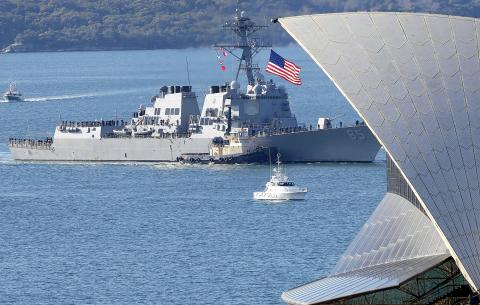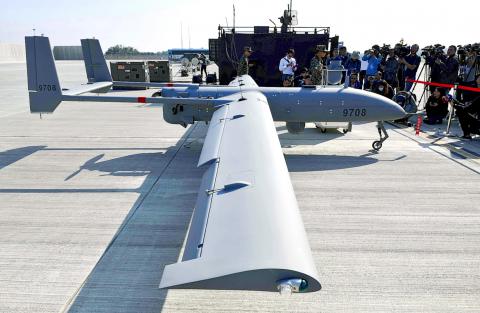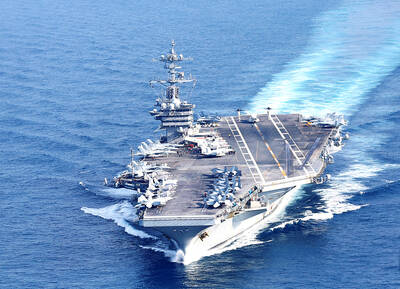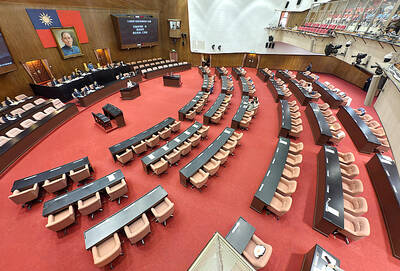The US Navy yesterday sailed two warships, the Arleigh Burke-class destroyer USS McCampbell and fleet replenishment oiler the USNS Walter S. Diehl, through the Taiwan Strait, official sources said.
The ships “conducted a routine Taiwan Strait transit” which is “in accordance with international law,” US Pacific Fleet spokesman Lieutenant Commander Tim Gorman told CNN.
The US Navy had sailed warships through the Taiwan Strait in October and November last year, marking a notable increase in the frequency of such operations that were previously conducted about once a year, CNN said.

Photo: AP
The US Defense Intelligence Agency earlier this month issued a report saying that China has undertaken military reforms and obtained technologies because of “Beijing’s longstanding interest to eventually compel Taiwan’s reunification with the mainland and deter any attempt by Taiwan to declare independence,” according to CNN.
US Chief of Naval Operations Admiral John Richardson said he told Chinese officials during a meeting last month that US policy toward Taiwan remains unchanged, and that Washington is “opposed to any kind of unilateral action from either side of the Strait that would change that status quo.”
In other news, the Taiwanese navy yesterday showed off its latest long-range surveillance drone as the nation’s outgunned armed forces push to counter China’s increasingly muscular rhetoric and military exercises.

Photo: Sam Yeh/AFP
The military has hosted multiple drills since Chinese President Xi Jinping’s (習近平) major speech about Taiwan on Jan. 2, emphasizing what it says is a readiness to counter any invasion.
The navy showed off its new, long-range surveillance drone, the Rui Yuan (銳鳶, Sharp Hawk), which officials said can fly for 12 hours and is helping to monitor movements in the Taiwan Strait.
“The drones are now an irreplaceable part of our reconnaissance strategy,” Ministry of National Defense spokesman Major General Chen Chung-chi (陳中吉) said.
“They are our primary option for activities in the Strait,” he said.
“The use of more locally made drones demonstrates Taiwan’s defense self-sufficiency and helps boost its reconnaissance capabilities,” said Wang Kao-cheng (王高成), a military analyst at Tamkang University.
The nation’s US-made F-16 and aging French-made Mirage jets are being increasingly called upon to respond to military movements from China, with some analysts warning that the fleet is getting worn down and lacking crucial spare parts.
Lin Ming-chang, an executive officer with the navy, said that drones were particularly cost-effective for surveillance.
“A pilot, when he flies, has to come back in two hours, but not the Rui Yuan drone. We can stay up in the air for up to 12 hours,” he said.
“In operating terms, both when it comes to fuel or machine parts, the drone can operate way longer than manned aircraft,” he added.
The navy yesterday also unveiled a hand-launched surveillance drone called “The Cardinal,” which it said can stay airborne for an hour.
In related news, the ministry yesterday said that it had observed and monitored the passage of People’s Liberation Army Air Force (PLAAF) planes to and from aircraft exercises in the west Pacific.
According to the ministry’s report yesterday afternoon, PLAAF planes — including the Shaanxi KJ-500 early-warning aircraft and Xian H-6 bombers — took off from airbases in southern China and passed the Bashi Channel on their way to the west Pacific.
The ministry said the planes took the same route back.
The air force and navy were dispatched to monitor the Chinese planes and ensure that they did not stray into Taiwanese air space, the ministry said.
The report is the second time this week that it observed Chinese planes conducting exercises.
On Tuesday, it observed Y-8 transports and Su-30 jets flying to the west Pacific through the Bashi Channel before returning to air bases in southern China via the same route.

CROSS-STRAIT COLLABORATION: The new KMT chairwoman expressed interest in meeting the Chinese president from the start, but she’ll have to pay to get in Beijing allegedly agreed to let Chinese Nationalist Party (KMT) Chairwoman Cheng Li-wun (鄭麗文) meet with Chinese President Xi Jinping (習近平) around the Lunar New Year holiday next year on three conditions, including that the KMT block Taiwan’s arms purchases, a source said yesterday. Cheng has expressed interest in meeting Xi since she won the KMT’s chairmanship election in October. A source, speaking on condition of anonymity, said a consensus on a meeting was allegedly reached after two KMT vice chairmen visited China’s Taiwan Affairs Office Director Song Tao (宋濤) in China last month. Beijing allegedly gave the KMT three conditions it had to

‘BALANCE OF POWER’: Hegseth said that the US did not want to ‘strangle’ China, but to ensure that none of Washington’s allies would be vulnerable to military aggression Washington has no intention of changing the “status quo” in the Taiwan Strait, US Secretary of Defense Pete Hegseth said on Saturday, adding that one of the US military’s main priorities is to deter China “through strength, not through confrontation.” Speaking at the annual Reagan National Defense Forum in Simi Valley, California, Hegseth outlined the US Department of Defense’s priorities under US President Donald Trump. “First, defending the US homeland and our hemisphere. Second, deterring China through strength, not confrontation. Third, increased burden sharing for us, allies and partners. And fourth, supercharging the US defense industrial base,” he said. US-China relations under

The Chien Feng IV (勁蜂, Mighty Hornet) loitering munition is on track to enter flight tests next month in connection with potential adoption by Taiwanese and US armed forces, a government source said yesterday. The kamikaze drone, which boasts a range of 1,000km, debuted at the Taipei Aerospace and Defense Technology Exhibition in September, the official said on condition of anonymity. The Chungshan Institute of Science and Technology and US-based Kratos Defense jointly developed the platform by leveraging the engine and airframe of the latter’s MQM-178 Firejet target drone, they said. The uncrewed aerial vehicle is designed to utilize an artificial intelligence computer

The Chinese Nationalist Party (KMT) caucus yesterday decided to shelve proposed legislation that would give elected officials full control over their stipends, saying it would wait for a consensus to be reached before acting. KMT Legislator Chen Yu-jen (陳玉珍) last week proposed amendments to the Organic Act of the Legislative Yuan (立法院組織法) and the Regulations on Allowances for Elected Representatives and Subsidies for Village Chiefs (地方民意代表費用支給及村里長事務補助費補助條例), which would give legislators and councilors the freedom to use their allowances without providing invoices for reimbursement. The proposal immediately drew criticism, amid reports that several legislators face possible charges of embezzling fees intended to pay